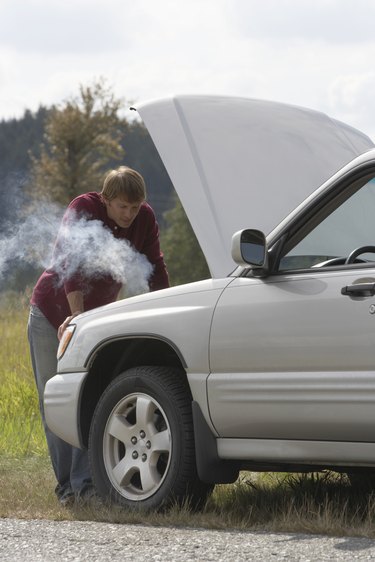
Thermostats are very simple by design, which means that failures are fairly rare. A thermostat will generally only fail in one of three ways; one isn't a particularly big deal, the others will thoroughly nuke your engine in minutes. Thermostat problems are easy to diagnose, and replacement is usually within the bounds of the average mechanic.
How a Thermostat Works
Considering what they do, a thermostat is triumph of simplicity and materials engineering. A thermostat has four basic parts: an outer housing, a disc-like thermostat valve, a return spring to push the valve closed and a piston assembly to push it open. The magic element in a thermostat is a wax pellet inside the cylinder; as cooling system temps rise, the wax pellet melts and expands to push on the piston in the cylinder. The piston pushes against the valve, and the thermostat opens.
Stuck Closed
There's a good chance that your failure will come from the wax and piston assembly, closing the valve and sticking it closed. This is extremely bad news for your engine, since coolant flow to the radiator will cease and the engine will overheat in minutes. Diagnosis is fairly simple. You need only remove the radiator cap, bring the engine up to temperature and look down into the radiator for coolant flow coming out of the upper radiator hose. If the coolant doesn't move and the radiator stays cold, you've got a thermostat problem.
Stuck Open
A thermostat stuck open won't hurt much aside from the fact that the engine will take longer to get up to temperature and may never reach its nominal operating temperature if outside temperatures are low. This probably isn't going to hurt the engine, but it will hurt horsepower, torque, fuel economy and possibly emissions. Low coolant temperatures can be especially problematic in winter, as coolant provides thermal energy for the heater. To check for a stuck-open valve, watch for coolant flow in the radiator with the engine cold. If coolant circulates with the engine cold, your thermostat is stuck open.
Stuck Halfway or Leaking
This isn't as uncommon as you might think, and it's probably more common than either a stuck fully open or shut condition. The piston rods in older thermostats can either jam halfway or the wax may degrade and fail to open it all the way. The symptoms are a combination of the stuck-open and stuck-shut conditions, but less severe and immediate. The engine may take longer to get up to temperature and then slowly overheat when it gets up to operating speed. The car may or may not overheat to failure, but it'll definitely run warmer than it should.